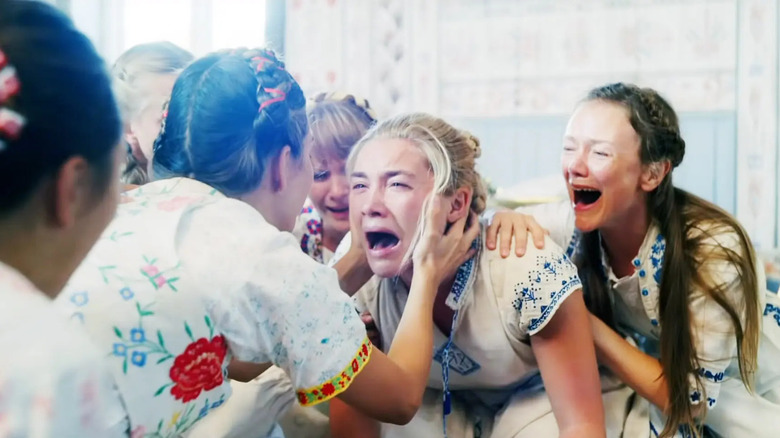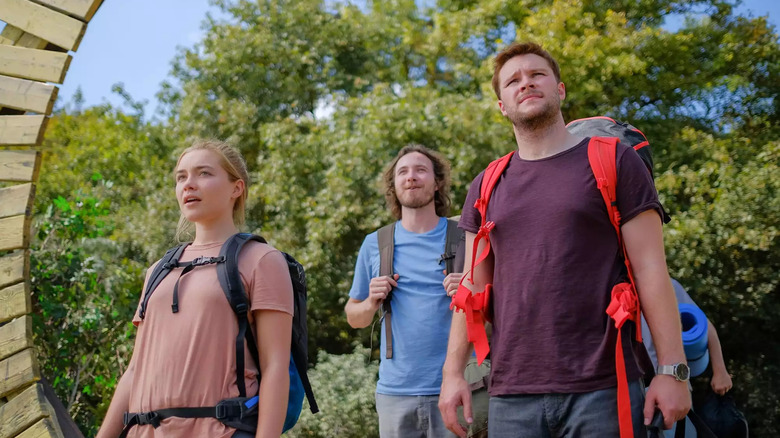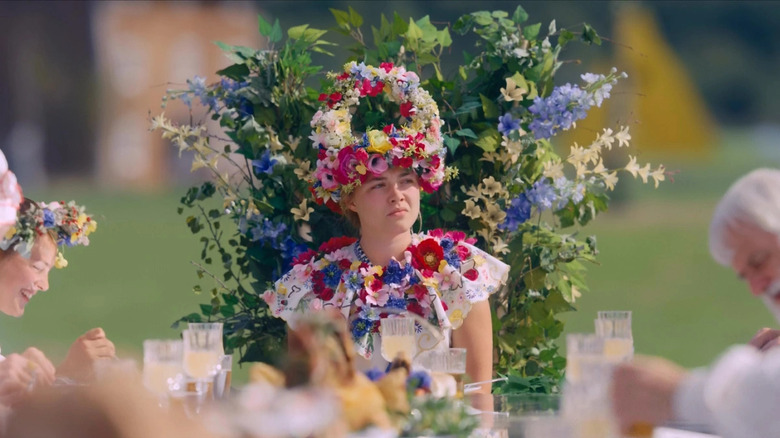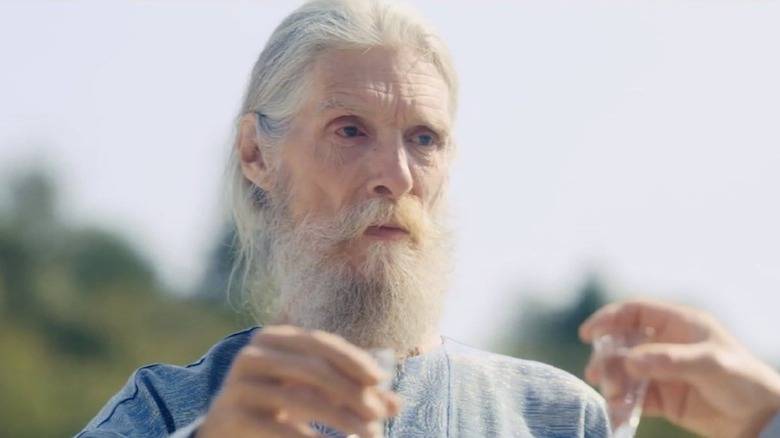How Midsommar Made Horror Out Of A Not-So-Scary Festival
Old folk traditions can sometimes seem a little bewildering to an outsider, especially in another country where local customs are already familiar. I'm not a huge fan of "Midsommar," but this is a key element of folk horror that Ari Aster gets right; that feeling of otherness you might get when finding yourself in a field surrounded by people all singing, dancing, drinking, and performing strange rituals.
I also speak from experience because I live in the Czech Republic, a country that generally engages in ancient traditions far more often than back in the UK. It took me a little while to adjust to some of the shenanigans that go on around here: The first time I saw some guys chasing a woman with canes at Easter time, I thought she was being attacked. It just turned out it was an old fertility rite and you can buy the canes, woven from willow branches, off almost any market.
Then comes the burning of the witches on the 30th of April, called Čarodějnice. People across the country gather around large bonfires to burn effigies of witches, symbolizing the thawing of winter's icy grip on the land, accompanied by plenty of beer, music, dancing, and grilled meats. Back in the UK, we burn Guy Fawkes in November, but this event is far more joyous, perhaps because people are giddy with excitement about the oncoming warm weather. The first time I went to one, I couldn't help thinking about "The Wicker Man."
This outsider sense of disquiet about folk practices is at the heart of "Midsommar," and the director, Ari Aster, didn't hold back when combining innocuous Swedish traditions with far darker ancient rites to create a summer festival you would definitely want to avoid.
So what happens in Midsommar again?
Psychology student Dani (Florence Pugh) is traumatized after her troubled sister killed herself and their parents by filling the house with carbon monoxide, which puts a further strain on her relationship with her boyfriend Christian (Jack Reynor). Christian was planning to break up with her but delayed the decision because of the sudden tragedy, which leads to another friction point.
Christian and his mates Mark (Will Poulter) and Josh (William Jackson Harper) have been invited along by a Swedish friend Pelle (Vilhelm Blomgren) to attend the summer solstice celebrations in the rural commune where he grew up in Hälsingland, Sweden. Dani's really upset that she wasn't invited and, despite the misgivings of his friends, Christian reluctantly says she can come, too.
They arrive at the remote commune and things seem pretty chill at first. People are relaxed and welcoming, the setting is idyllic, and there is plenty of time to hang out ting shrooms and enjoying the extra-long hours of sunshine, which casts the whole village in an eerie light.
Things take a turn for the horrific when the visitors watch a ritual where two elderly members of the commune willingly leap from a high cliff to their deaths. They decide this isn't cool and consider leaving, but Dani and Christian discover that there is an ulterior motive to their invitation to the festival. Meanwhile, their friends suffer a series of nasty deaths, before Dani realizes there might be a place for her at the commune despite all the horror.
Aster has done his research for "Midsommar" but he doesn't have a firm grip on what makes folk horror as a genre so insidious. He just can't help himself throwing in some forensically disturbing gore, which only serves to shatter the great atmosphere he initially creates.
Maypoles, May Queens, and gross practical magic
The summer solstice is a big deal in many European countries. Many thousands descend on Stonehenge in the UK to watch the sun align with the megaliths, while people in the Austrian Tyrol mark the occasion by lighting fires on the mountainsides. In Scandinavian countries where winter nights are very long, the extra hours of sunlight are especially welcome, and midsummer's eve is cause for many Swedes to head to the countryside to celebrate (via (Elle).
One tradition that the commune in "Midsommar" share with their real-life counterparts is the maypole, a tradition dating back thousands of years. The Swedish maypole is erected fully decorated with leaves and flowers and provides a focal point for dancing. This goes hand-in-hand with the commune's striking folk costumes and flower crowns, and it is still common in Sweden to make floral wreaths and headdresses. Traditionally, it was a way to harness the magic of the natural world and girls could divine who they would marry by placing flowers under their pillows.
In pagan beliefs, the May Queen was locked in an ongoing battle with the Queen of Winter, although the practice of selecting a young woman to represent her is a relatively new one (via Learn Religions). In parts of Britain, a Queen of May is still chosen to head the May Day parade, but it is lesser known these days in Sweden.
In another scene, a young woman tries a rather gross piece of practical magic by placing pubic hair in Christian's pie to make him fall in love with her. Similar practices existed in Sweden whereby putting menstrual blood, urine, or sweat in a boy's drink could secure his affections, but they were not directly linked to midsummer celebrations.
Cliff jumping and blood eagles
Perhaps more than any other folk horror movies, "The Wicker Man" and "Midsommar" have popularized the idea that pagans and isolated rural communities once conducted human sacrifices as part of their local customs. Both films end with an important character dying a horrible fiery death, but Ari Aster added some more gruesome methods of sacrifice and torture to make his tale extra horrific.
The film's most notorious scene is when the two old folk jump from the cliff to their grisly demise on the rocks below. This is Aster's spin on a Scandinavian myth called Ättestupa (via GQ) derived from the word for cliffs or precipices where elderly people in prehistoric times either leaped or were thrown to their deaths when they became a burden to the community. Historians doubt it was ever a real practice and has nothing to do with midsummer celebrations in Sweden or elsewhere.
Another nasty death Aster adds for his customary shock value is that of Simon (Archie Madekwe), a fellow traveler who is punished for trying to leave the commune in the worst way possible. Christian discovers him strung up in a chicken coop looking like the Cenobites have had a go at him. He has suffered the barbarous practice called the Blood Eagle, by which a victim's ribs are severed from their spine so the lungs can be pulled out through their back. This gnarly way of dying is long associated with the Vikings and derived from old Norse sagas (via Smithsonian), and scholars have debated whether this was really a thing or just an imaginative method of revenge cooked up by the original authors.
The bear suit
The dumbest scene in "Midsommar" is saved for last when Christian is drugged, sewn inside a bear carcass, and burned alive. As a devoted fan of "The Wicker Man" original, it just triggered memories of Nic Cage disguised as a bear in the terrible remake. Aster seems to have made this fancy-dress element of human sacrifice up, although the choice of bear has significance.
In Norse mythology, Odin sometimes took the form of a bear when visiting the human realm, and legends tell of Viking warriors entering a violent trance while wearing bearskins in battle; the word "berserker" originates from "bear-shirt" or bear coat" (via The Ringer). They are not only a symbol of strength but also healing and inner wisdom, none of which seem to apply to the victim.
Christian's death does resemble one particularly horrid method of murdering martyrs in the early days of Christianity. All their bones would be broken before getting sewn up inside a dead horse, then thrown to scavenging creatures that would eat them alive. Nero was apparently a fan of this technique, and another version of this heinous practice came from Ancient Greece, where a Christian woman was sewn inside a dead horse with only her head exposed and left to roast alive in the searing sun (via History Collection).
Ari Aster did a fair job of lacing innocuous Swedish traditions with far more gruesome myths and legends, although I find the darker stuff overpowers the film and rips away any subtlety. One thing we can say is that if you find yourself in Sweden or any other country and the locals start singing, dancing, and indulging in folk customs, it's okay. Go ahead, join in. They are almost certainly not going to burn you alive.




